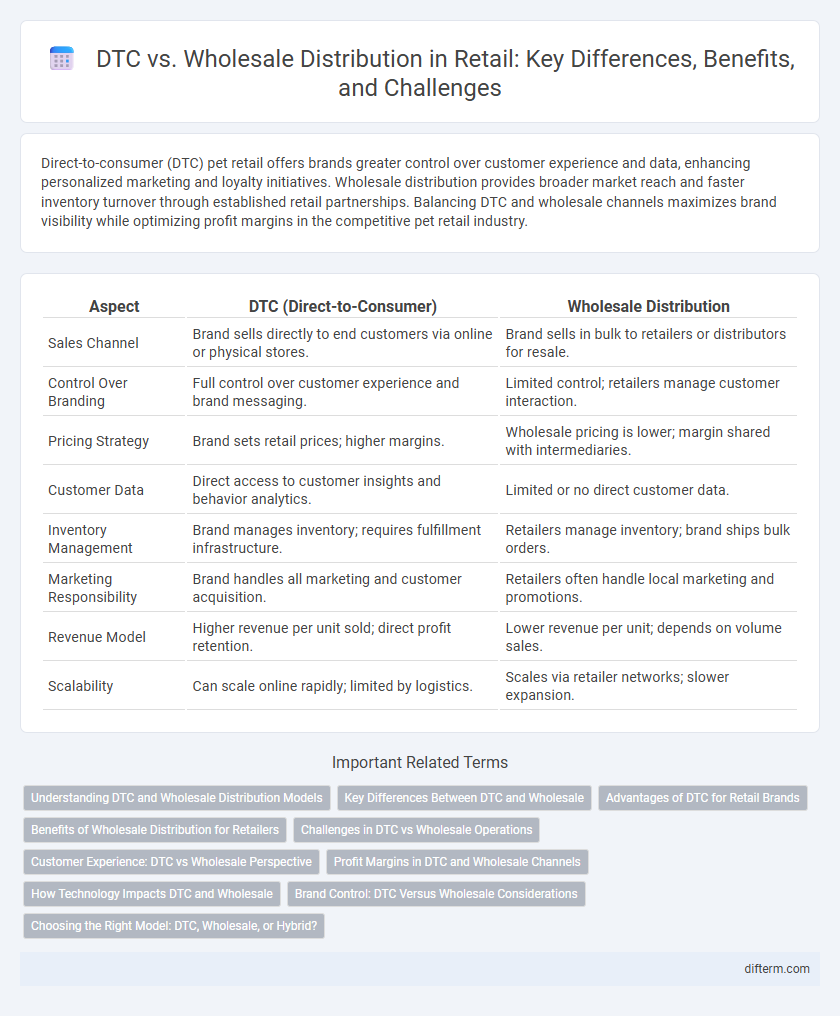Direct-to-consumer (DTC) pet retail offers brands greater control over customer experience and data, enhancing personalized marketing and loyalty initiatives. Wholesale distribution provides broader market reach and faster inventory turnover through established retail partnerships. Balancing DTC and wholesale channels maximizes brand visibility while optimizing profit margins in the competitive pet retail industry.
Table of Comparison
| Aspect | DTC (Direct-to-Consumer) | Wholesale Distribution |
|---|---|---|
| Sales Channel | Brand sells directly to end customers via online or physical stores. | Brand sells in bulk to retailers or distributors for resale. |
| Control Over Branding | Full control over customer experience and brand messaging. | Limited control; retailers manage customer interaction. |
| Pricing Strategy | Brand sets retail prices; higher margins. | Wholesale pricing is lower; margin shared with intermediaries. |
| Customer Data | Direct access to customer insights and behavior analytics. | Limited or no direct customer data. |
| Inventory Management | Brand manages inventory; requires fulfillment infrastructure. | Retailers manage inventory; brand ships bulk orders. |
| Marketing Responsibility | Brand handles all marketing and customer acquisition. | Retailers often handle local marketing and promotions. |
| Revenue Model | Higher revenue per unit sold; direct profit retention. | Lower revenue per unit; depends on volume sales. |
| Scalability | Can scale online rapidly; limited by logistics. | Scales via retailer networks; slower expansion. |
Understanding DTC and Wholesale Distribution Models
Direct-to-consumer (DTC) distribution allows brands to sell products directly to customers, enhancing control over brand messaging and customer experience while increasing profit margins by eliminating intermediaries. Wholesale distribution involves selling goods in bulk to retailers or other businesses, enabling broader market reach and faster inventory turnover but often resulting in lower per-unit profits. Understanding these models helps retailers balance brand control, market exposure, and operational scalability to optimize revenue and customer engagement.
Key Differences Between DTC and Wholesale
DTC (Direct-to-Consumer) distribution involves brands selling products directly to customers, eliminating intermediaries, which allows for better control over pricing, branding, and customer experience. Wholesale distribution relies on third-party retailers or partners to purchase and resell products, often resulting in lower margins but broader market reach. Key differences include control over customer data, margin structures, and marketing strategy flexibility.
Advantages of DTC for Retail Brands
Direct-to-consumer (DTC) retail brands benefit from higher profit margins by eliminating intermediaries commonly found in wholesale distribution. They gain enhanced control over brand messaging, customer experience, and data collection, enabling personalized marketing and stronger customer relationships. This direct interaction facilitates quicker market feedback, allowing brands to swiftly adapt to consumer preferences and trends.
Benefits of Wholesale Distribution for Retailers
Wholesale distribution offers retailers bulk purchasing options that reduce per-unit costs and improve profit margins. Access to a diverse range of products from multiple manufacturers enables retailers to expand inventory variety and meet customer demand effectively. Efficient supply chain management through wholesale distributors ensures timely stock replenishment and reduces the risk of inventory shortages.
Challenges in DTC vs Wholesale Operations
DTC operations face challenges such as managing direct customer relationships, handling order fulfillment, and ensuring personalized marketing, which require advanced data analytics and customer service infrastructure. Wholesale distribution struggles with complexities in inventory management, maintaining strong retailer partnerships, and navigating bulk order logistics, often leading to longer supply chain cycles. Both models require robust technology integration to optimize operations and meet shifting consumer demands efficiently.
Customer Experience: DTC vs Wholesale Perspective
Direct-to-consumer (DTC) retail offers a personalized customer experience through tailored marketing, exclusive products, and direct feedback channels, enhancing brand loyalty and satisfaction. Wholesale distribution focuses on volume sales and broad market reach but often lacks the individualized service and immediate responsiveness found in DTC models. The DTC approach enables brands to control the entire customer journey, resulting in higher engagement and deeper insights into consumer behavior compared to traditional wholesale channels.
Profit Margins in DTC and Wholesale Channels
Direct-to-consumer (DTC) channels typically yield higher profit margins compared to wholesale distribution due to the elimination of intermediaries and direct control over pricing. Wholesale distribution often involves significant discounting and volume-based pricing, which can compress margins despite larger order quantities. Retailers leveraging DTC benefit from enhanced customer data insights, enabling optimized marketing strategies and improved profitability per transaction.
How Technology Impacts DTC and Wholesale
Technology revolutionizes DTC by enabling advanced customer data analytics, personalized marketing, and seamless e-commerce platforms that drive direct consumer engagement and higher profit margins. Wholesale distribution benefits from technology through automated inventory management, real-time demand forecasting, and streamlined supply chain logistics, enhancing operational efficiency and order accuracy. Both models leverage digital tools differently, with DTC focusing on customer experience optimization and wholesale emphasizing bulk order coordination and distributor relationships.
Brand Control: DTC Versus Wholesale Considerations
Direct-to-consumer (DTC) distribution grants brands complete control over product presentation, pricing, and customer experience, fostering stronger brand identity and loyalty. Wholesale distribution often limits this control as retailers set in-store merchandising and promotional strategies, which can dilute brand messaging. Maintaining brand consistency and direct customer engagement remains a critical advantage of the DTC model in retail strategy.
Choosing the Right Model: DTC, Wholesale, or Hybrid?
Choosing the right distribution model hinges on a brand's goals, target audience, and resource allocation; Direct-to-Consumer (DTC) offers higher margins and direct customer insights, while Wholesale ensures broader market reach through established retailers. A hybrid approach combines the strengths of both, enabling brands to optimize revenue streams and enhance market penetration without sacrificing control or customer experience. Retailers must analyze factors such as supply chain complexity, brand positioning, and profit margin targets to determine the most effective strategy.
DTC vs Wholesale Distribution Infographic

 difterm.com
difterm.com